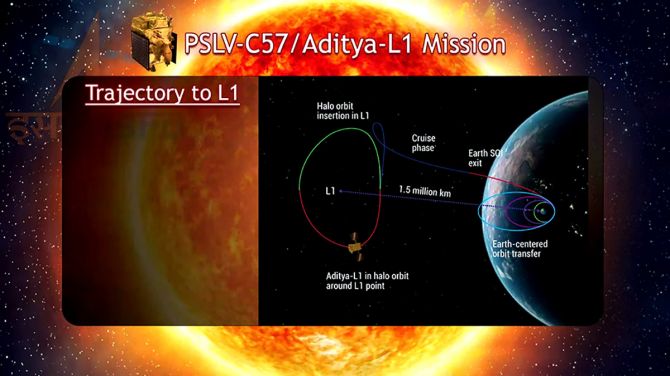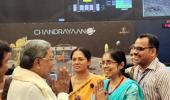India's first solar mission, if successful, will showcase ISRO's ability to explore the cosmos, explains Kumar Abishek.

There is a compelling adage: 'Shoot for the moon. Even if you miss, you'll land among the stars'.
Well, India's recent moonshot has been a uniquely successful tale, with Chandrayaan-3's Vikram making a soft landing near the lunar South Pole and rover Pragyan leaving its imprints on its surface and in our hearts.
It's time we shot for a star -- our nearest, the Sun -- and expanded our scientific frontiers.
The Indian Space Research Organisation launched the Aditya-L1 mission, dedicated to studying the Sun, on September 2, 2023.
It was launched by ISRO's PSLV rocket from the Satish Dhawan Space Centre in Sriharikota.
Solar missions are special due to the fundamental role of the Sun in shaping our solar system and lifeforms on Earth.
India's upcoming probe is a remarkable endeavour that exemplifies the importance of such missions.
Let's understand the mission first. ISRO plans to place the observatory in a halo orbit around the Lagrangian point 1 (L1) of the Sun-Earth system, about 1.5 million km from Earth.
The journey will take nearly four months; the planned mission duration is five years.
Lagrange points are positions in space where the gravitational forces of two celestial bodies, such as the Sun and Earth, equal the centripetal force required for a small object to move with them, according to the National Aeronautics and Space Administration (NASA), and this helps a spacecraft reduce fuel consumption needed to remain in position.
Of the five Lagrange points, three are unstable (L1, L2, and L3) and two (L4 and L5) are stable.
'A satellite placed in the halo orbit around the L1 point has the major advantage of continuously viewing the Sun without any occultation/eclipse,' according to ISRO.
NASA's Solar and Heliospheric Observatory Satellite (SOHO) is currently placed there.

Via Aditya L1, ISRO scientists will study the Sun's corona (the outermost part of its atmosphere) and seek to comprehend the mechanisms behind the corona's high temperatures, even higher than the Sun's surface.
The mission will also investigate the origins of solar wind and its effects on the heliosphere -- a bubble that extends beyond the orbits of the planets and helps shield them from interstellar radiation.
Additionally, the observatory will study coronal mass ejections (CMEs), massive eruptions of plasma and magnetic fields from the corona. But why undertake this ambitious mission?

The Sun is not just a source of energy for us, but also a living laboratory for studying stellar processes, such as nuclear fusion, magnetic field dynamics, and the generation of solar wind.
Studying the Sun's interior through methods like helioseismology (or through its oscillations), akin to how earthquakes reveal the Earth's interior, offers valuable data for refining models of stellar evolution.
And, knowledge about these processes enhances our understanding of the cosmos.
Furthermore, solar missions provide insights into the Sun's role in shaping the habitability of planets within our solar system.
Variations in the Sun's energy output can influence our planet's climate patterns over long periods.
Studying this will help scientists refine climate models, and understand the complex interactions between solar radiation and atmospheric processes.
Great bursts of electromagnetic energy and particles, or solar flares, can temporarily alter Earth's upper atmosphere, disrupting signal transmissions in an increasingly technology-driven world.
CMEs can lead to electromagnetic and ground-level electric fluctuations, potentially damaging the power grids.
People and organisations can protect themselves or be prepared following advance information on such episodes. Aditya L1 is a step in that direction, too.

In line with such objectives, the payload of the Aditya L1 mission includes instruments like the visible emission line coronagraph, the solar ultraviolet imaging telescope, the solar low energy X-ray spectrometer, and the plasma analyser package for Aditya.
These instruments will help scientists capture high-resolution images of the corona, study its emissions, observe the Sun as a star, and investigate solar wind by analysing electrons and heavier ions.
Understanding these processes not only expands our knowledge of the Sun but also offers insights into plasma physics.
Data and information gained from the Aditya L1 mission will translate into tangible benefits for space operations and technology on Earth -- from optimising satellite operations to enhancing GPS accuracy.

India's first solar mission, if successful, will showcase ISRO's ability to explore the cosmos and push the boundaries of our understanding through curiosity, innovation, and determination.
After lunar successes, achievements of Aditya L1 will portray ISRO not as a rising Sun, but as a Sun that has already risen, shining brightly at the peak of summer.
Feature Presentation: Rajesh Alva/Rediff.com











